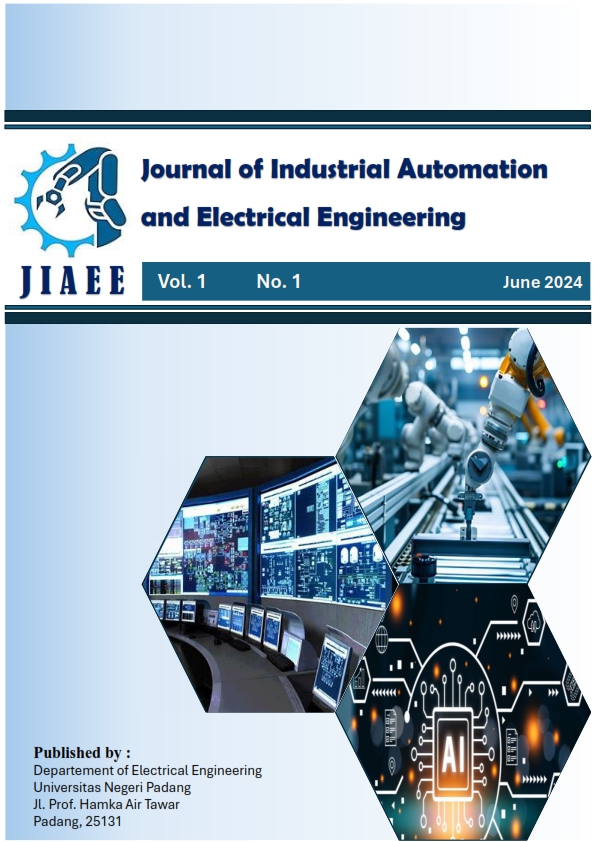Control of Buck Converter Using Artificial Neural Network
Keywords:
Buck converter, Voltage control, Artificial Neural Network , ArduinoAbstract
Electrical energy has an important role in various aspects of life. Electrical energy is used in the form of alternating current (AC) voltage and direct current (DC) voltage. To produce a direct voltage (DC) that varies and as needed, a power converter is needed that is equipped with a control system so that the resulting voltage remains stable and does not experience overvoltage or undervoltage. In this research, the converter used is a buck converter. Because the buck converter is a nonlinear system, it requires a control system with a dynamic response rate. So it is necessary to design a buck converter by applying a control system that can maintain the stability of the buck converter output voltage efficiently and adaptively such as the Artificial Neural Network (ANN) method. The control proposed system will be implemented using an Arduino ATMega2560 programmed through Simulink Matlab. To test the effectiveness of this control system, several experiments will be conducted with an input voltage of 24 Volts and outputs worth 9 and 12 Volts. From this test, a voltage error of 0.1 Volt was obtained in the experiment with constant voltage and constant load criteria, proving that the control has successfully controlled the buck converter output voltage according to the reference voltage
Downloads
References
[1] N. J. Harahap, “Mahasiswa Dan Revolusi Industri 4.0,” Ecobisma (Jurnal Ekonomi, Bisnis Dan Manajemen), vol. 6, no. 1, pp. 70–78, 2019.
[2] M. Veerachary and Anu, "Stability Analysis of Higher-order Buck Converters: Participation Factors Approach", Proc. of IEEE International Conference on Computing Power and Communication Technologies (GUCON), pp. 165-170, 2020.
[3] M. Saputra, S. Djulihenanto, and I. Fadlika, “Implementasi Kendali Tegangan Lup Tertutup Buck Converter dengan Arduino Mega,” Elposys: Jurnal Sistem Kelistrikan, vol. 8, no. 1, pp. 11–15, 2023.
[4] S. Misal and M. Veerachary, "Analysis of a Fourth Order Step-Down Converter", 2018 IEEE International Conference on Power Electronics Drives and Energy Systems (PEDES), pp. 1-5, 2018.
[5] A. Anggawan and M. Yuhendri, “Kendali Tegangan Output Buck Converter Menggunakan Arduino Berbasis Simulink Matlab,” JTEIN: Jurnal Teknik Elektro Indonesia, vol. 2, no. 1, pp. 34–39, 2021.
[6] D. Rahmawati, M. Ulum, M. Farisal, and K. Joni, “Lantai Pembangkit Listrik Menggunakan Piezoelektrik dengan Buck Converter LM2596,” Jurnal Arus Elektro Indonesia, vol. 7, no. 3, p. 84, 2021.
[7] M. Veerachary, "Analysis of Minimum-Phase Fourth-Order Buck DC-DC Converter", IEEE Trans. on Indus. Electron., vol. 63, no. 1, pp. 144-154, Jan. 2016.
[8] M. Zainal arifin and R. Ika Putri, “Implementasi Kontroler PI Pada Buck Converter Sebagai Pengaturan Tegangan Konstan Di Sistem Turbin Angin Permanent Magnet Schronous Generator (PMSG) Dilengkapi Sistem Monitoring Berbasis IoT,” Journal of Applied Smart Electrical Network and Systems, vol. 2, no. 2, pp. 43–48, 2021.
[9] P. Azer and A. Emadi, "Generalized state space average model for multi-phase interleaved buck boost and buck-boost dc-dc converters: Transient steady-state and switching dynamics", IEEE Access, vol. 8, pp. 77735-77745, 2020.
[10] M. Leng, G. Zhou, S. Zhou, K. Zhang and S. Xu, "Stability analysis for peak current-mode controlled buck LED driver based on discrete-time modeling", IEEE J. Emerg. Sel. Top. Power Electron., vol. 6, no. 3, pp. 1567-1580, 2017.
[11] M. -W. Kim, J. -J. Kim, “A PWM/PFM dual-mode DC-DC buck converter with load-dependent efficiency-controllable scheme for multi-purpose IoT applications,” Energies, vol. 14, no. 4, pp. 960(1–14), Feb. 2021.
[12] H. Sucu, T. Göktas, M. Arkan, “Design, simulation and application of buck converter with digital PI controller,” Balkan Journal of Electrical and Computer Engineering, vol. 9, no. 2, pp. 106–113, Apr. 2021.
[13] A. F. Rifai, W. Purnomo, and R. E. Putri, “Rancang Bangun Dc To Dc Buck Converter Dengan Sistem Kendali Pi Pada Ni Elvis Ii Dan Antarmuka Berbasis Labview,” JTT (Jurnal Teknologi Terapan), vol. 7, no. 2, p. 129, 2021, doi: 10.31884/jtt.v7i2.333.
[14] L. Guo, J. Y. Hung, and R. M. Nelms, “Evaluation of DSP-based PID and fuzzy controllers for DC-DC Converters,” IEEE Trans. Ind. Electron., vol. 56, no. 6, pp. 2237–2248, 2009.
[15] S. Misal and M. Veerachary, "Analysis of a sixth-order higher bucking converter", 2017 4th IEEE Uttar Pradesh Section International Conference on Electrical Computer and Electronics (UPCON), pp. 410-415, 2017.
[16] D. Sinaga, “Jaringan Saraf Tiruan Infeksi Mata Dengan Menggunakan Metode Beraksitektur Multi Layer Perceptron,” Informasi dan Teknologi Ilmiah (INTI), vol. 7, no. 2, pp. 189–192, 2020.
[17] S. Solikhun, M. Safii, and A. Trisno, “Jaringan Saraf Tiruan Untuk Memprediksi Tingkat Pemahaman Sisiwa Terhadap Matapelajaran Dengan Menggunakan Algoritma Backpropagation,” J-SAKTI (Jurnal Sains Komputer dan Informatika), vol. 1, no. 1, p. 24, 2017.
[18] I. F. Sanul and M. Yuhendri, “Sistem Kendali MPPT Panel Surya Dengan Menggunakan Algoritma Jaringan Saraf Tiruan,” JTEIN: Jurnal Teknik Elektro Indonesia, vol. 4, no. 1, pp. 345–352, 2023.
[19] X. Li, X. Zhang, F. Lin and F Blaabjerg, "Artificial-intelligence-based design for circuit parameters of power converters", IEEE Transactions on Industrial Electromcs, vol. 69, no. 11, pp. 11144-11155, 2021.
[20] B. Jacob et al., "Quantization and training of neural networks for efficient integer-arithmetic-only inference", Proc. IEEE Conf. Comput. Vis. Pattern Recognit. (CVPR), pp. 2704-2713, 2018.
[21] O. I. Abiodun, A. Jantan, A. E. Omolara, K. V. Dada, N. A. Mohamed and H. Arshad, "State-of-the-art in artificial neural network applications: A survey", Heliyon, vol. 4, no. 11, 2018..
[22] J. Ramirez-Hernandez, O. U. Juarez-Sandoval, K. Cano-Pulido, J. F. Marquez-Rubio, and N. Mondragon-Escamilla, “Online learning artificial neural network controller for a buck converter,” 2019 IEEE International Autumn Meeting on Power, Electronics and Computing, ROPEC 2019, no. Ropec, pp. 6–10, 2019.
[23] Li Xiao, Yushan Liu and Yaosuo Xue, "Four-switch buck-boost converter based on model predictive control with smooth mode transition capability", IEEE Transactions on Industrial Electronics, vol. 68, no. 10, pp. 9058-9069, 2020.
[24] W. W. A. Ramadhan and T. Abuzairi, "Simulation and Analysis of a Buck Converter Based on an Arduino PWM Signal Using a Single Cell Li-Ion Load", International Conference on Quality in Research, 2019.
[25] D. R. Brafianto, I. Wijono, and T. Nurwati, “Aplikasi kontrol fuzzy pada manajemen penyimpanan energi kendaraan listrik,” Forum Pendidik. Tinggi Tek. Elektro Indonesia, pp. 267–272, 2021







